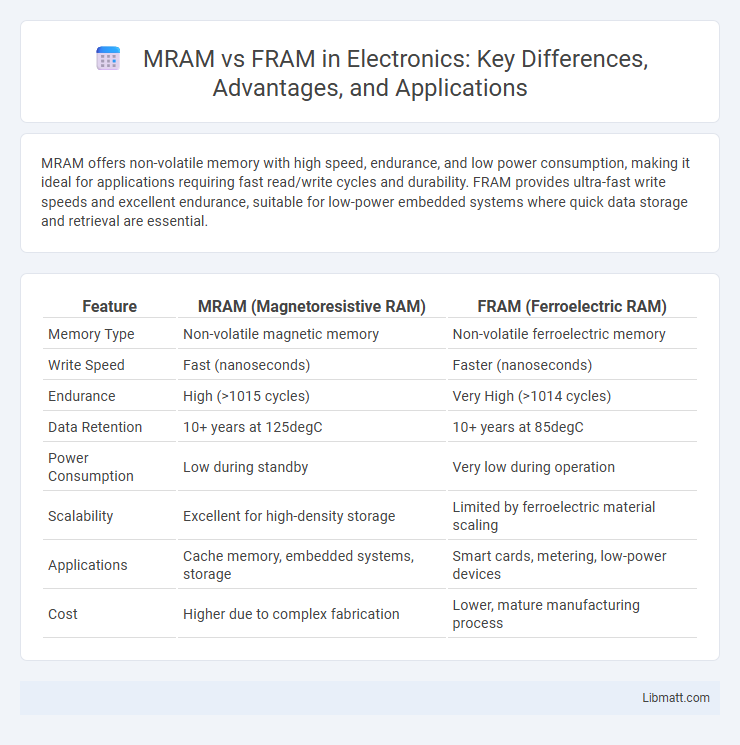MRAM offers non-volatile memory with high speed, endurance, and low power consumption, making it ideal for applications requiring fast read/write cycles and durability. FRAM provides ultra-fast write speeds and excellent endurance, suitable for low-power embedded systems where quick data storage and retrieval are essential.
Table of Comparison
| Feature | MRAM (Magnetoresistive RAM) | FRAM (Ferroelectric RAM) |
|---|---|---|
| Memory Type | Non-volatile magnetic memory | Non-volatile ferroelectric memory |
| Write Speed | Fast (nanoseconds) | Faster (nanoseconds) |
| Endurance | High (>1015 cycles) | Very High (>1014 cycles) |
| Data Retention | 10+ years at 125degC | 10+ years at 85degC |
| Power Consumption | Low during standby | Very low during operation |
| Scalability | Excellent for high-density storage | Limited by ferroelectric material scaling |
| Applications | Cache memory, embedded systems, storage | Smart cards, metering, low-power devices |
| Cost | Higher due to complex fabrication | Lower, mature manufacturing process |
Introduction to MRAM and FRAM
MRAM (Magnetoresistive Random-Access Memory) utilizes magnetic states to store data, offering non-volatility, high endurance, and fast read/write speeds ideal for cache memory and embedded systems. FRAM (Ferroelectric Random-Access Memory) employs ferroelectric materials to retain data through electric polarization, providing low power consumption, high write speed, and excellent durability suited for sensor and industrial applications. Both MRAM and FRAM represent advanced non-volatile memory technologies designed to overcome limitations of traditional memory types like DRAM and Flash.
Fundamental Principles of MRAM
MRAM (Magnetoresistive Random Access Memory) stores data by exploiting magnetic states rather than electrical charges, using magnetic tunnel junctions (MTJs) composed of two ferromagnetic layers separated by an insulating barrier. Data is written by changing the magnetic orientation of one layer via spin-transfer torque, enabling non-volatile and high-speed memory operations with excellent endurance. Your choice of MRAM technology offers advantages such as low power consumption and high reliability compared to charge-based memories like FRAM.
Core Technology Behind FRAM
FRAM (Ferroelectric RAM) relies on a ferroelectric layer to store data, using the polarization of the ferroelectric material to represent binary information, which enables non-volatile memory with fast write speeds and low power consumption. Unlike MRAM, which uses magnetic tunnel junctions to switch magnetic states, FRAM's core technology centers on the reversible polarization of ferroelectric capacitors, offering high endurance and data retention without the need for refresh cycles. Understanding this fundamental difference helps you choose the ideal memory technology based on required speed, durability, and power efficiency.
Comparative Memory Architectures
MRAM (Magnetoresistive Random-Access Memory) utilizes magnetic tunnel junctions for data storage, enabling non-volatile memory with high endurance and fast access times, while FRAM (Ferroelectric Random-Access Memory) relies on ferroelectric capacitors to retain data through electric polarization states. MRAM's architecture supports higher density integration and better scalability, making it suitable for applications requiring robust performance and durability. In contrast, FRAM offers low power consumption and fast write capabilities but faces limitations in density and scalability compared to MRAM.
Speed and Performance Analysis
MRAM (Magnetoresistive Random-Access Memory) offers faster write speeds compared to FRAM (Ferroelectric RAM), typically in the nanosecond range, enabling higher data throughput and low latency. FRAM, while slightly slower in write speed, provides excellent endurance with millions of write cycles and consumes less power during data retention, making it ideal for low-power applications. Performance analysis shows MRAM excels in applications demanding rapid data processing, whereas FRAM is preferred where energy efficiency and high write endurance are critical.
Power Consumption Differences
MRAM (Magnetoresistive Random-Access Memory) consumes power primarily during write operations due to the need for magnetic field generation, resulting in moderate energy usage, while FRAM (Ferroelectric RAM) features ultra-low power consumption for both read and write cycles by leveraging electric polarization, making it highly energy-efficient. FRAM's non-destructive read capability significantly reduces power draw compared to MRAM's typically higher energy requirements associated with magnetic switching. These differences make FRAM ideal for battery-powered and energy-sensitive applications, whereas MRAM suits scenarios requiring higher endurance and speed despite its comparatively higher power consumption.
Data Retention and Endurance
MRAM (Magnetoresistive Random-Access Memory) offers excellent data retention with non-volatile storage that can last for decades, making it highly reliable for long-term data storage. FRAM (Ferroelectric Random-Access Memory) provides superior endurance, supporting up to 10^14 write cycles, which significantly exceeds traditional flash memory and benefits applications requiring frequent rewrites. While MRAM balances moderate endurance around 10^12 cycles with exceptional retention, FRAM's endurance and power efficiency favor real-time data logging and rapid write-read operations.
Applications and Use Cases
MRAM excels in applications requiring fast read/write speeds and high endurance, such as cache memory in processors, automotive systems, and industrial IoT devices where data retention and durability are critical. FRAM is favored in low-power, high-reliability environments like smart cards, RFID tags, and medical devices due to its ultra-low power consumption and excellent endurance for frequent writes. Both memory types support non-volatile storage but differ in optimal use cases based on speed, power efficiency, and endurance requirements.
Cost Efficiency and Scalability
MRAM offers higher cost efficiency for large-scale production due to its simpler fabrication process and compatibility with existing CMOS technology, enabling lower per-bit costs as volumes increase. FRAM, while providing faster write speeds and lower power consumption, tends to have higher manufacturing costs and limited scalability because of complex material requirements and smaller density potential. Your choice depends on whether you prioritize cost-effective scalability with MRAM or the speed and endurance advantages of FRAM for specific low-power applications.
Future Prospects: MRAM vs FRAM
MRAM (Magnetoresistive Random Access Memory) offers superior scalability, faster write speeds, and higher endurance, making it highly promising for next-generation memory applications such as AI and IoT devices. FRAM (Ferroelectric RAM) excels in ultra-low power consumption and quick read/write cycles, particularly beneficial for low-energy embedded systems. Your choice between MRAM and FRAM should depend on specific requirements like performance, energy efficiency, and use case longevity in future technology landscapes.
MRAM vs FRAM Infographic

 libmatt.com
libmatt.com